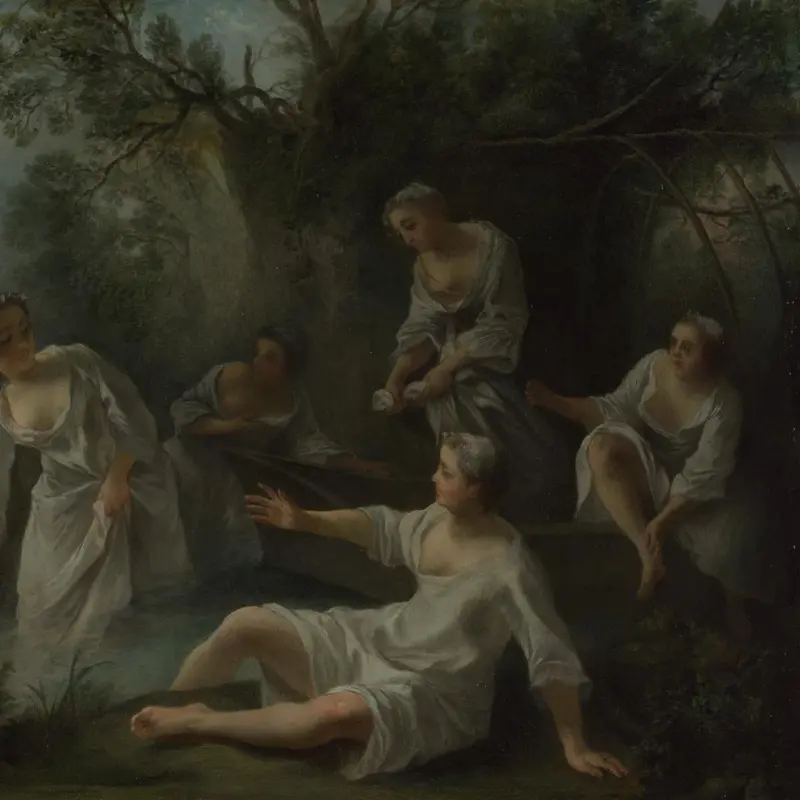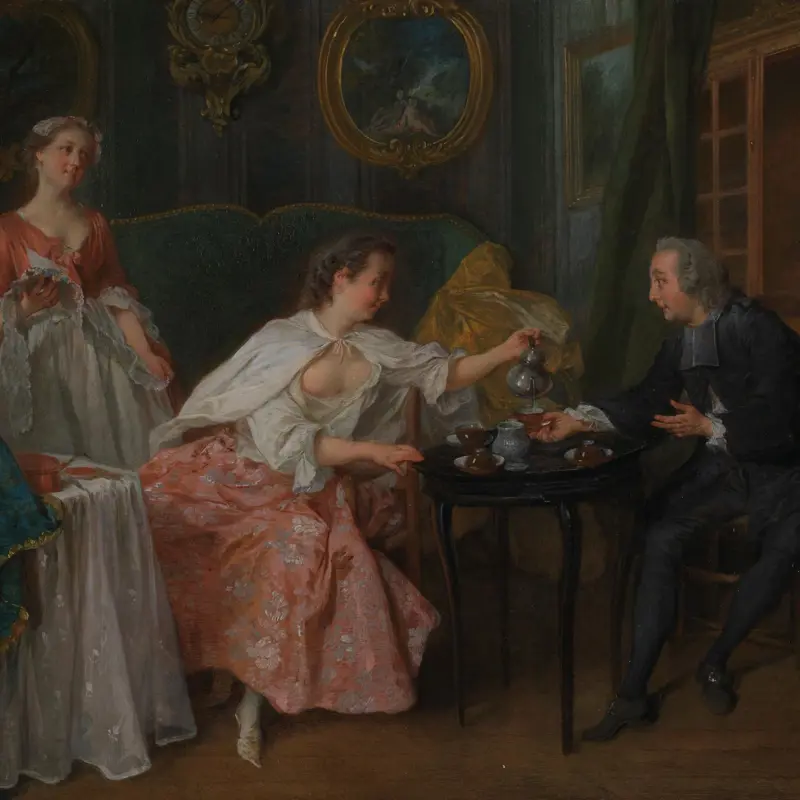Nicolas Lancret, 'The Four Ages of Man: Childhood', about 1733-4
About the work
Overview
This is the first of Lancret’s series of paintings depicting The Four Ages of Man.
Ten wealthy children, a baby, a nurse and a governess are outside in a tiled neoclassical loggia. Two of the children are being taught to read by the governess, while the others are playing boisterous games. A boy and a girl with long ribbons pull along a child seated on the baby’s walking frame. A pair of girls hold the child’s hands and join the game, while two others play with a mask. The rosy-cheeked nursemaid holds the baby and watches the antics of her young charges.
This was probably the first of the series to be painted by Lancret in 1733, as the two girls playing with a mask also appear in his Dance between a Pavilion and a Fountain (Charlottenburg Palace, Berlin) of 1733.
Key facts
Details
- Full title
- The Four Ages of Man: Childhood
- Artist
- Nicolas Lancret
- Artist dates
- 1690 - 1743
- Part of the series
- The Four Ages of Man
- Date made
- about 1733-4
- Medium and support
- oil on canvas
- Dimensions
- 34.5 × 45.7 cm
- Acquisition credit
- Bequeathed by Lt-Col John Harvey Ollney, 1837
- Inventory number
- NG101
- Location
- Not on display
- Collection
- Main Collection
- Previous owners
Provenance
Additional information
Text extracted from the ‘Provenance’ section of the catalogue entry in Humphrey Wine, ‘National Gallery Catalogues: The Eighteenth Century French Paintings’, London 2018; for further information, see the full catalogue entry.
Exhibition history
-
2015Joie de VivrePalais des Beaux-Arts (Lille)26 September 2015 - 17 January 2016
Bibliography
-
1874S. Ballot de Sovot, Éloge de Lancret: Peintre du roi, ed. J. Guiffrey, Paris 1874
-
1875E. Bocher, Les graveurs françaises du XVIIIe siècle, Paris 1875
-
1876E. Bocher, Les gravures françaises du XVIIIe siècle, Paris 1876
-
1924G. Wildenstein, Lancret, Paris 1924
-
1946Martin Davies, National Gallery Catalogues: French School, London 1946
-
1957Martin Davies, National Gallery Catalogues: French School, 2nd edn (revised), London 1957
-
1995F. Gétreau, 'Les tableaux et les dessins français du XVIIIe siècle', Gazette des beaux-arts, CXXXVII, 1995, pp. 177-90
-
1997E. Langmuir, Allegory, London 1997
-
2001
C. Baker and T. Henry, The National Gallery: Complete Illustrated Catalogue, London 2001
-
2018Wine, Humphrey, National Gallery Catalogues: The Eighteenth Century French Paintings, London 2018
About this record
If you know more about this work or have spotted an error, please contact us. Please note that exhibition histories are listed from 2009 onwards. Bibliographies may not be complete; more comprehensive information is available in the National Gallery Library.
Images
About the series: The Four Ages of Man

Overview
Lancret treats the traditional subject of The Four Ages of Man as a series of contemporary genre scenes – Childhood, Adolescence, Youth and Old Age.
In Childhood (L'Enfance), a group of wealthy children play boisterous games in an open-air loggia watched by their nurse and governess. In Adolescence (L’Adolescence), a young woman admires herself in a mirror while her hair is decorated with ribbons and flowers. Instead of depicting the third age as a time of maturity and showing a middle-aged married couple, Lancret paints several pairs of lovers in a woody glade, and entitles the picture Youth (La Jeunesse). In Old Age (La Vieillesse), he dispenses with the usual depiction of old people warming themselves indoors before an open fire to take the scene outdoors.
The set was engraved in reverse by Nicolas de Larmessin III in 1735. Most of the numerous painted copies were copied from the prints and are also shown in reverse.









